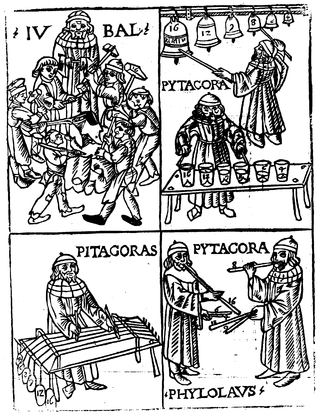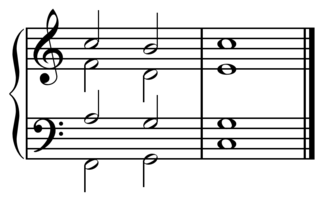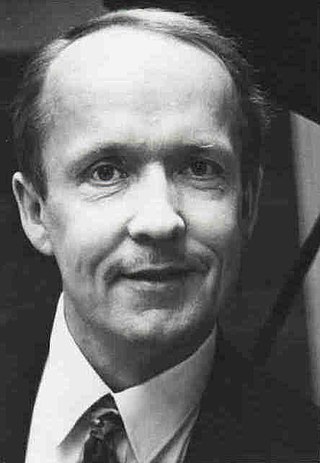Musicology is the scholarly analysis and research-based study of music. Musicology departments traditionally belong to the humanities, although some music research is scientific in focus. Some geographers and anthropologists have an interest in musicology so the social sciences also have an academic interest. A scholar who participates in musical research is a musicologist.
Semiotics is the systematic study of sign processes (semiosis) and meaning making. Semiosis is any activity, conduct, or process that involves signs, where a sign is defined as anything that communicates something, usually called a meaning, to the sign's interpreter. The meaning can be intentional, such as a word uttered with a specific meaning; or unintentional, such as a symptom being a sign of a particular medical condition. Signs can also communicate feelings and may communicate internally or through any of the senses: visual, auditory, tactile, olfactory, or gustatory (taste). Contemporary semiotics is a branch of science that studies meaning-making and various types of knowledge.

Music theory is the study of the practices and possibilities of music. The Oxford Companion to Music describes three interrelated uses of the term "music theory". The first is the "rudiments", that are needed to understand music notation ; the second is learning scholars' views on music from antiquity to the present; the third is a sub-topic of musicology that "seeks to define processes and general principles in music". The musicological approach to theory differs from music analysis "in that it takes as its starting-point not the individual work or performance but the fundamental materials from which it is built."
Music history, sometimes called historical musicology, is a highly diverse subfield of the broader discipline of musicology that studies music from a historical point of view. In theory, "music history" could refer to the study of the history of any type or genre of music. In practice, these research topics are often categorized as part of ethnomusicology or cultural studies, whether or not they are ethnographically based. The terms "music history" and "historical musicology" usually refer to the history of the notated music of Western elites, sometimes called "art music".
Schenkerian analysis is a method of analyzing tonal music based on the theories of Heinrich Schenker (1868–1935). The goal is to demonstrate the organic coherence of the work by showing how the "foreground" relates to an abstracted deep structure, the Ursatz. This primal structure is roughly the same for any tonal work, but a Schenkerian analysis shows how, in each individual case, that structure develops into a unique work at the foreground. A key theoretical concept is "tonal space". The intervals between the notes of the tonic triad in the background form a tonal space that is filled with passing and neighbour tones, producing new triads and new tonal spaces that are open for further elaborations until the "surface" of the work is reached.

Art music is music considered to be of high phonoaesthetic value. It typically implies advanced structural and theoretical considerations or a written musical tradition. In this context, the terms "serious" or "cultivated" are frequently used to present a contrast with ordinary, everyday music. Many cultures have art music traditions; in the Western world the term typically refers to Western classical music.

Tonality is the arrangement of pitches and/or chords of a musical work in a hierarchy of perceived relations, stabilities, attractions and directionality. In this hierarchy, the single pitch or triadic chord with the greatest stability is called the tonic. The root of the tonic chord forms the name given to the key, so in the key of C major, the note C can be both the tonic of the scale and the root of the tonic chord. The tonic can be a different note in the same scale, when the work is said to be in one of the modes of the scale.
Susan Kaye McClary is an American musicologist associated with "new musicology". Noted for her work combining musicology with feminist music criticism, McClary is professor of musicology at Case Western Reserve University.
New musicology is a wide body of musicology since the 1980s with a focus upon the cultural study, aesthetics, criticism, and hermeneutics of music. It began in part a reaction against the traditional positivist musicology of the early 20th century and postwar era. Many of the procedures of new musicology are considered standard, although the name more often refers to the historical turn rather than to any single set of ideas or principles. Indeed, although it was notably influenced by feminism, gender studies, queer theory, postcolonial studies, and critical theory, new musicology has primarily been characterized by a wide-ranging eclecticism.

Eero Aarne Pekka Tarasti, is a Finnish musicologist and semiologist, currently serving as Professor Emeritus of Musicology at the University of Helsinki.
A museme is a minimal unit of musical meaning, analogous to a morpheme in linguistics, "the basic unit of musical expression which in the framework of one given musical system is not further divisible without destruction of meaning." A museme may:
Music semiology (semiotics) is the study of signs as they pertain to music on a variety of levels.
In music cognition and musical analysis, the study of melodic expectation considers the engagement of the brain's predictive mechanisms in response to music. For example, if the ascending musical partial octave "do-re-mi-fa-sol-la-ti-..." is heard, listeners familiar with Western music will have a strong expectation to hear or provide one more note, "do", to complete the octave.
Marcel Danesi is Professor of Semiotics and Linguistic Anthropology at the University of Toronto. He is known for his work in language, communications and semiotics and is Director of the program in semiotics and communication theory. He has also held positions at Rutgers University (1972), University of Rome "La Sapienza" (1988), the Catholic University of Milan (1990) and the University of Lugano.

Gabriel Pareyon is a polymathic Mexican composer and musicologist, who has published literature on topics of philosophy and semiotics.
Embodied music cognition is a direction within systematic musicology interested in studying the role of the human body in relation to all musical activities.

Popular music pedagogy — alternatively called popular music education, rock music pedagogy, or rock music education — is a development in music education consisting of the systematic teaching and learning of popular music both inside and outside formal classroom settings. Popular music pedagogy tends to emphasize group improvisation and is more often associated with community music activities than fully institutionalized school music ensembles.
Computational musicology is an interdisciplinary research area between musicology and computer science. Computational musicology includes any disciplines that use computers in order to study music. It includes sub-disciplines such as mathematical music theory, computer music, systematic musicology, music information retrieval, computational musicology, digital musicology, sound and music computing, and music informatics. As this area of research is defined by the tools that it uses and its subject matter, research in computational musicology intersects with both the humanities and the sciences. The use of computers in order to study and analyze music generally began in the 1960s, although musicians have been using computers to assist them in the composition of music beginning in the 1950s. Today, computational musicology encompasses a wide range of research topics dealing with the multiple ways music can be represented.
Semiotics of music videos is the observation of symbolism used within music videos.
Matthew G. Brown is a British-American music theorist, musicologist, educator, and artistic director. He is Professor of Music Theory at Eastman School of Music.






